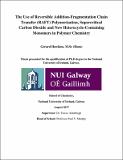| dc.contributor.advisor | Aldabbagh, Fawaz | |
| dc.contributor.author | Hawkins, Gerard | |
| dc.date.accessioned | 2017-08-29T11:35:26Z | |
| dc.date.issued | 2017-08-28 | |
| dc.identifier.uri | http://hdl.handle.net/10379/6766 | |
| dc.description.abstract | Chapter 1 is a general introduction with a description of conventional radical polymerization and reversible deactivation radical polymerizations for controlled/living techniques. In particular, the use of Reversible Addition Fragmentation Chain Transfer (RAFT) polymerization and benign supercritical carbon dioxide (scCO2) are included.
Chapter 2 describes a new controlled/living heterogeneous polymerization in scCO2. Poly(2-ethoxyethyl methacrylate) macroRAFT agent is insoluble in scCO2 and forms a whitish emulsion at the polymerization conditions of 65 C and 30 MPa. The precipitated macroRAFT agent is used in controlled/living polymerizations with N,N-dimethylacrylamide and 4-acryloylmorpholine (4AM) with induced precipitation polymerizations in scCO2 compared with solution polymerizations. The faster RAFT of 4AM was taken to 70% conversion in scCO2 to give powders that were washed with scCO2 to remove traces of monomer, offering a green large scale route to the synthesis of poly(2-ethoxymethyl methacrylate)-b-(acrylamides) useful for potential biomedical applications. This work is published in J. Polym. Sci., Part A: Polym Chem. 2015, 53, 2351-2356.
Chapter 3 describes Polymerization Induced Self-Assembly (PISA) and examines the possibility of its use to form higher order objects in heterogeneous controlled/living radical polymerizations in scCO2. After reviewing literature PISA using emulsion/dispersion polymerizations in conventional solvents, an attempt at Atom Transfer Radical Polymerization (ATRP) of benzyl methacrylate (BzMA) using a dispersion polymerization from poly(dimethylsiloxane) bromide in scCO2 is described. Some non-spherical morphologies were apparent, but further work is required, including altering the size of the solvophobic poly(BzMA) block.
Chapter 4 describes the first efficient synthesis of the N-[(cycloalkylamino)methyl]acrylamide monomer class. The monomer synthesis involves addition of acrylamide onto in situ generated methylene Schiff Base salts with monomer hydrochloride salt intermediates also isolated on multi-gram scale. The macroRAFT agent of the morpholine monomer was extended with tert-butylacrylamide to give amphiphilic block copolymers that self-assembled into large rod-like vesicles. For the triblock of similar hydrophobic monomer content, but incorporating the piperidine monomer, a very different aggregation was observed with pH-expandable nanoparticle spheres observed. Part of this chapter is published in J. Polym. Sci., Part A: Polym Chem. 2017, 55, 2123-2128. | en_IE |
| dc.rights | Attribution-NonCommercial-NoDerivs 3.0 Ireland | |
| dc.rights.uri | https://creativecommons.org/licenses/by-nc-nd/3.0/ie/ | |
| dc.subject | Chemistry | en_IE |
| dc.subject | Polymer chemistry | en_IE |
| dc.subject | Supercritical carbon dioxide | en_IE |
| dc.subject | Reversible addition-fragmentation chain transfer (RAFT) | en_IE |
| dc.subject | Heterocycle-containing monomers | en_IE |
| dc.title | The use of reversible addition-fragmentation chain transfer (RAFT) polymerization, supercritical carbon dioxide and new hetero-containing monomers in polymer chemistry | en_IE |
| dc.type | Thesis | en_IE |
| dc.local.note | The aim of this thesis was to make new biocompatible smart or stimuli-sensitive polymers using controlled/living polymerization processes in supercritical carbon dioxide and the synthesis of new heterocycle-containing monomers and the polymerization of said monomers. | en_IE |
| dc.description.embargo | 2019-08-28 | |
| dc.local.final | Yes | en_IE |
| nui.item.downloads | 255 | |


